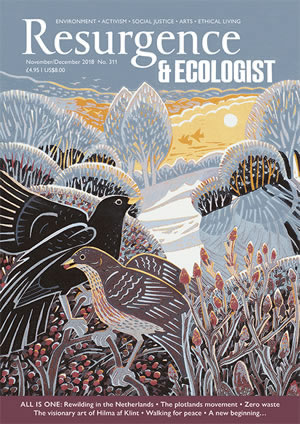Narratives matter. They establish the architecture for the telling of stories about the state of the world and how we should act. During the mid-20th century a powerful environmental narrative emerged that has shaped institutions and cultural understandings of our relationship with Nature, the planet and different actors in society. At its root, this narrative adopts a simple state-cause-consequence structure. Nature is in crisis due to human fecundity, greed and ignorance, and catastrophe looms. The activist generation of the 1970s populated this narrative with villainous, innocent and heroic characters and called on governments to act to regulate the perpetrators of harm and for companies to change their immoral ways.
This narrative is powerful and has achieved much, but it mobilises action through a combination of anxiety and blame. The relentless retelling of ‘doom and gloom’ stories may have alienated many ordinary people from the environmental movement: the issues seem so big that people feel powerless to make a difference within the constraints of their everyday lives.
Early in 2019, the UK government will introduce the first broad environmental bill in 20 years. Campaigners are calling for it to be ambitious, but in what way? The established environmental narrative frames ambition in terms of halting loss through more powerful regulation, targets and watchdogs. Significantly the consultation document states that the government’s ambition is to “enhance and restore habitats and landscapes”, not just protect and conserve them.
The new bill may be the first in the world to include a legal duty to leave the environment in better shape than we found it. This ‘restoration’ ambition raises an important set of questions: what do we want to restore? What natural processes, attributes and types of value do we wish to enhance or recover? Who should decide on these questions? Mobilising this ambition will require a new environmental narrative: one that empowers collective imaginings of the future environments we wish to create.
I recently published an article in the journal Ambio suggesting that in rewilding we are seeing the emergence of a new environmental narrative, which I labelled “Recoverable Earth”. In structure, ethos and ambition it is quite different from the established environmental narrative.
It is characterised by fresh and compelling stories telling of the return and recovery of European megafauna, the restoration of natural dynamics and ecological abundance: stories of reassessment and refinding the self, and working with restored forces of Nature to create novel solutions to the challenges of environmental and social change. They are stories of what can be achieved rather than what needs to be done.
Interestingly, these new stories of environmental recovery map onto the narrative structure of accounts of mental health recovery. These commonly incorporate four narrative components: accounts of (1) despair, anguish and hopelessness, (2) awakenings and reassessments, (3) decisions to act, often in the company of others, leading to (4) the recovery of hope and wellness. Rewilding stories assemble these components in a synergistic manner. For example, the story of Gelderse Poort, located immediately upriver from the city of Nijmegen (Europe’s 2018 Green Capital) begins with accounts of despair concerning the loss of natural values in the Dutch delta. It continues with two key ecological awakenings: that, given space, Nature can spontaneously recover; and that grazing aids the development of rich and diverse ecosystems. This inspired a pilot project to acquire agricultural land in the floodplain and introduce grazing with ‘wilded’ ponies and cattle. This radical new vision attracted funds and interest: it prompted WWF-Netherlands to reassess its attitude towards aggregate mining. WWF-Netherlands formed a partnership with brick companies, which purchased more agricultural land and excavated the accumulated silt and clay to restore the river.
The story continues with accounts of the rapid and unexpected recovery of Nature and how this has enhanced the life quality of Nijmegen’s citizens: rare species have returned, dune and freshwater systems previously known only from coastal or higher areas have appeared, and citizens benefit from reduced flood risk, low insurance costs and the many outdoor recreation opportunities the restored landscape offers – from beach sunbathing to wildlife watching.
Gelderse Poort is a story of the recovery of socio-ecological wellness. New stories of environmental recovery and restoration lack the blame and catastrophic consequence components of the older narrative. They adopt a more pragmatic worldview: we are where we are, there is no way back, and there is little value in feeling guilt and attributing blame.
Interpreting the ‘re’ prefix as ‘again’ rather than ‘back’ creates the flexibility to envision better, yet different environmental futures. It creates the architecture to explore and discuss the restoration questions noted above and the policy principles that should follow.
Adopting a new environmental narrative does not mean abandoning the old. Twenty-first-century environmentalism could adopt the strapline “Protect the best, recover the rest”, where the first part of the couplet refers to the regulations and natural areas established in the 20th century, and the second part refers to new policy, projects and campaigns that take inspiration from multiple pasts to restore degraded landscapes and ecological processes and recover wellness for people and Nature.
There is talk of the UN declaring 2020–30 as a decade of ecosystem restoration. The Recoverable Earth narrative offers a structure for telling environmental stories that are fresh, hopeful, intriguing and empowering. Adopting this narrative in environmental policy, communication and marketing could instil people with the confidence to act with an independence of spirit and vision to restore their landscapes and ecosystems and recover a sense of collective wellbeing.








